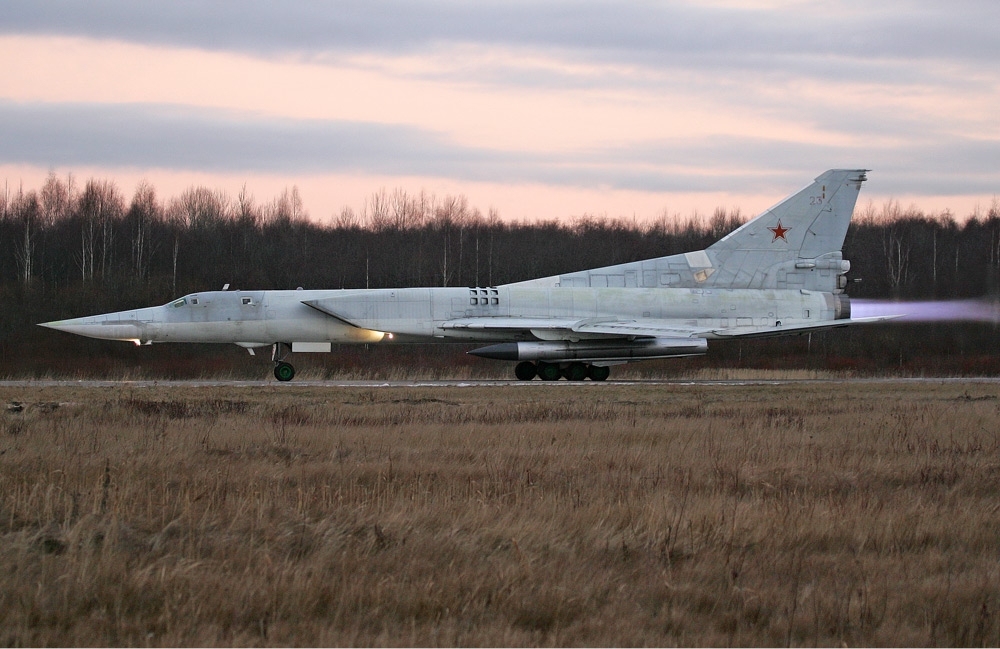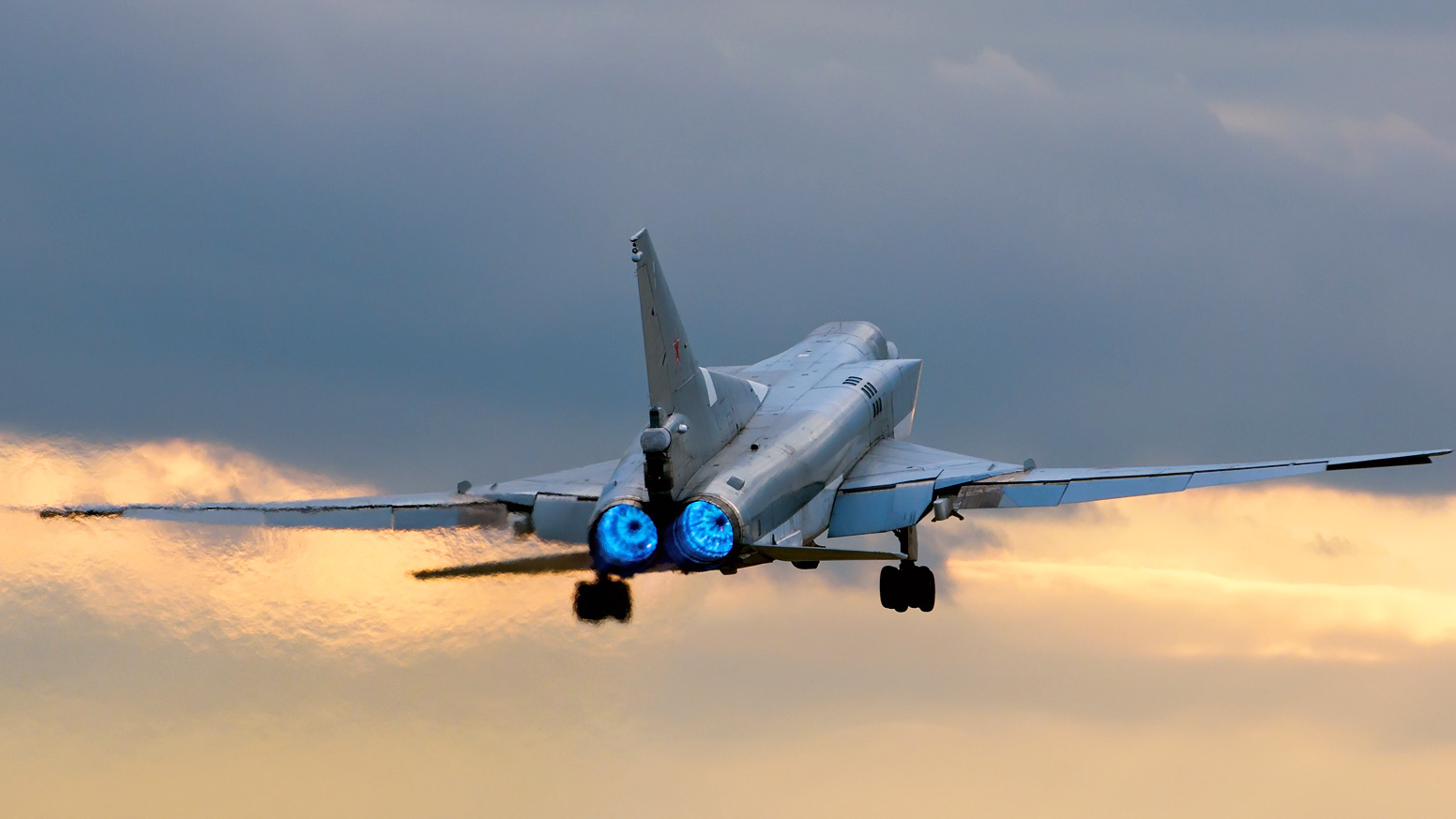A brief video clip posted to social media may provide a first view of a Russian long-range bomber in combat during the conflict in Ukraine. While there have been consistent reports of Russian Aerospace Forces, or VKS, bombers being used in the war, video or photographic evidence of their actual employment has so far proven highly elusive.
The 1-minute 19-second video, apparently posted by the fighter_bomber account, which is very active on the Russian Telegram messaging site, purports to show the launch of cruise missiles, as seen from the cockpit of a Tu-22M3 Backfire-C bomber of the VKS. The nighttime sequence, filmed from the co-pilot’s right-hand seat, shows two missiles launched in fairly quick succession, before these climb up to cruising altitude. The pilot in the left-hand seat gestures toward the missiles as they streak away, remarking “Death to fascists!”
The latter comment would seem to indicate that the missiles were indeed launched against targets in Ukraine, where Russia has repeatedly claimed its forces are fighting a battle against ‘Nazification.’ Apart from this, there is nothing to tie the video clip specifically to the ongoing conflict, although the audio segment does at least appear to be genuine.
As for the two weapons being launched, these are Kh-22 series supersonic cruise missiles, which today are carried exclusively by the Tu-22M3.
The Cold War-era Kh-22, known to NATO as AS-4 Kitchen, dates back to the early 1960s and production ceased as long ago as 1988.

The delta-wing missile is powered by a liquid-fuel rocket and is typically launched from a Tu-22M3 flying at a speed of Mach 1.5. The missile then accelerates to Mach 3 before approaching the target. In its terminal phase, the missile dives at a steep angle and attains a maximum speed of over Mach 4. Each Tu-22M3 can carry up to three of these missiles in overload configuration, although one is more usual.
Originally, the Kh-22 was developed for attacking major warships, such as aircraft carriers, or for use against high-priority static targets on land. Two different guidance systems were available, an active radar seeker for use against ships, and a radar seeker combined with Doppler navigation and autopilot for prosecuting land targets.
In Cold War times, the Kh-22 was primarily armed with a nuclear warhead, although an alternative conventional high-explosive charge was available for the anti-ship version. The limited accuracy of the land-attack version meant that this one previously only carried a nuclear warhead, which would have been used against large targets like airfields or ports.
Other versions of the Kh-22 (for anti-shipping or land-attack) were optimized for either high-altitude or low-altitude launch, the latter being an option introduced on late-production weapons.

Interestingly, the video, if indeed taken during combat in Ukraine, would not only suggest that the Kh-22 made its combat debut during the conflict but also that a conventional warhead has been made available for the land-attack Kh-22MA/NA, or the anti-shipping Kh-22M/N has somehow been repurposed to attack targets on land. Reportedly, the land-attack versions of the Kh-22 had a circular error probability (CEP) of up to 3.1 miles, making the feasibility of a conventionally armed version of one of these highly questionable in most scenarios.
Another option is that the missiles being launched are the much-modernized Kh-32 versions, which retain the same physical characteristics of the Kh-22 but offer improved performance.
While the Kh-22MA/NA has a maximum range of a little over 300 miles, the Kh-32 has a new control system and flight profile that reportedly extends the range to over 550 miles.
The Kh-32 apparently entered low-scale production in around 2005 and is said to be a dual-purpose anti-shipping/land attack weapon, although its current service status is unclear.
Apparent Kh-32 test rounds carried by Tu-22M3s:
Whatever the type of missiles launched, the video does support multiple claims, including from the Ukrainian Ministry of Defense, that the Tu-22M3 has been used in combat in Ukraine.
In mid-April, it was widely reported that Tu-22M3s had been used to bomb the Azovstal steel factory in Mariupol, a site of determined Ukrainian resistance that still continues. It’s unclear if these ‘bombing’ raids involved cruise missiles as well as the free-fall ‘dumb’ bombs that the Tu-22M3 can also carry internally and externally. On the other hand, even the comparatively huge CEP of the Kh-22 might be suitable considering the size of the steel plant and the deep nature of its tunnels and bunkers, which could potentially be breached by the high-speed missile.
Aside from the Tu-22M3, one other Russian heavy bomber, the Tu-95MS Bear-H, has reportedly been involved in the conflict since it began with a cruise missile assault against high-priority targets on February 24.
There are, so far, no confirmed reports of third Russian heavy bomber, the Tu-160 Blackjack, having been used in the conflict, although it’s certainly a possibility.
Unlike the Tu-22M3, the Tu-95MS and Tu-160 are only able to carry cruise missiles, not bombs. Conventional options are the Kh-555 and Kh-101 air-launched cruise missiles although, so far, there has been no firm evidence of the Kh-555 being used. On the other hand, social media imagery confirms the use of the more sophisticated (and more expensive) Kh-101, which differs in having a stealthier profile. It’s been suggested the apparent Kh-555 no-show is due to stocks being depleted in the Syrian campaign, and not backfilled.
At the beginning of the month, a U.S. defense official said that Russia had launched almost 2,125 missiles into Ukraine in 68 days of war, or a little over 30 missile launches per day. However, it was not clear how many of these were air-launched.
Overall, the extent of Russian cruise missile usage is widely acknowledged to have resulted in stocks of these, and other precision-guided weapons, being significantly reduced. It’s also been suggested that the tough sanctions placed on Russia are making it difficult to procure certain high-technology components required for the production of these and similar weapons.
With that in mind, the apparent use of veteran Kh-22 missiles could well suggest that stocks of more modern and capable missiles are running so low that the VKS is now looking for alternatives that may well be less than entirely suitable to the mission.
The advantage of all these cruise missiles, including the Kh-22, is that they can be launched from well outside Ukraine’s borders, meaning that VKS bombers don’t have to face the threat of Ukrainian ground-based air defenses or fighter jets. Indeed, the long-range Kh-101 could be launched from above the VKS bomber base at Engels in western Russia and still reach targets anywhere in Ukraine.
One disadvantage, it would appear, is the limited accuracy achieved with these weapons. Back in March, a senior U.S. defense official said: “Either they’re failing to launch, or they’re failing to hit the target, or they’re failing to explode on contact.” That, if true, could also help explain why key elements of the Ukrainian Armed Forces, including parts of its air force, are still continuing to fight effectively, despite repeated missile barrages.
As to why the VKS bomber arm has been keeping such a low profile during the war, compared to the tactical jets and rotary forces, that’s hard to say, but it’s conceivable that it’s also a reflection on the limited results achieved so far. During the campaign in Syria, in contrast, the Russian bombers were very much in the media spotlight.
Tu-22M3s (and MiG-31s armed with Kinzhal air-launched ballistic missiles) arrive at Khmeimim Air Base in Syria for a deployment earlier this year:

With its aging cruise missiles and otherwise entirely unguided ordnance, the Tu-22M3 may look impressive and has been used to signal Russian military might elsewhere in the world. However, there is little doubt that it’s an asset that is hardly well suited to rooting out Ukrainian resistance in an urban scenario like Mariupol.
But with stocks of more advanced cruise missiles seemingly diminishing fast, it wouldn’t be a surprise if utilization of the Tu-22M3 in the war in Ukraine actually increases as the air campaign continues.
Contact the author: thomas@thedrive.com
